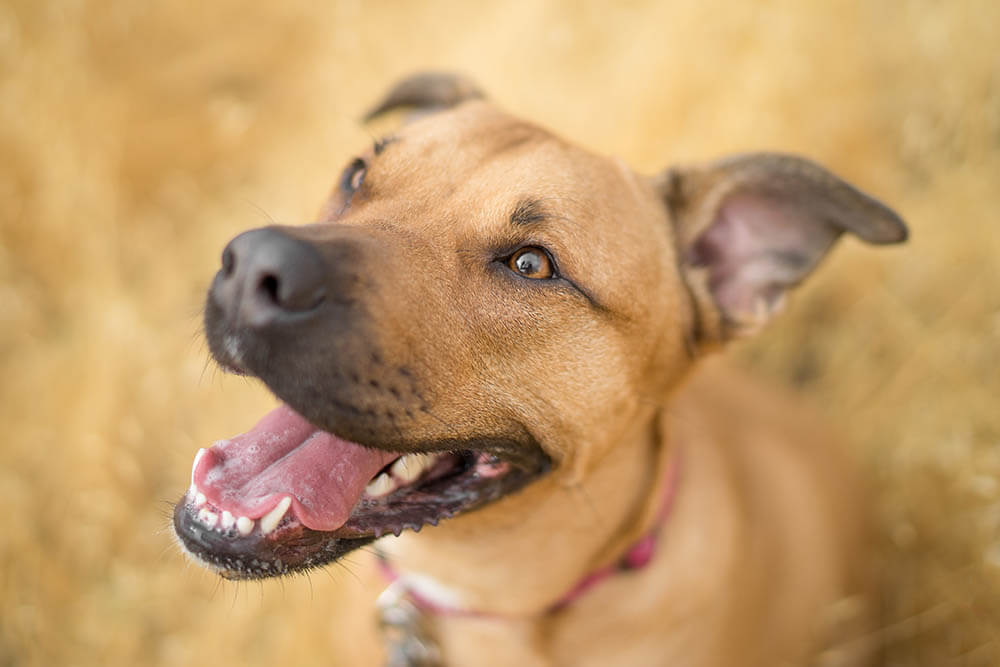Just because dogs can’t speak doesn’t mean they’re incapable of communication. Our canine pals are, in fact, extremely expressive creatures, only they rely on body language to make their feelings known. In fact, dogs use almost their entire body to express emotions, from the tail to the ears.
So what, exactly, is your pet trying to tell you when they pull their ears backward? And what does it mean when the gesture is accompanied by other behaviors, such as a wagging tail or a hunched back?
Read on to find out!

8 Reasons Why Dogs Pin Their Ears Back
The ears are an excellent indicator of what your dog is feeling or thinking. If you want a glimpse into their mind, you should therefore learn what the different ear positions mean, especially when combined with other behaviors.
In this article, we’ll be focusing on why dogs pin their ears back, a behavior that can express any of the following:
1. Happiness or comfort
When a dog is happy, they may position their ears backward, resulting in a pinned-back-ears look.
Of course, dog ears come in all shapes and sizes, so ears that are pulled back don’t always look the same for every breed. For instance, when a Siberian Husky or any other breed with naturally erect ears pulls their ears back, the tips of their ears point backward and upward. But when a floppy-eared dog positions theirs backward, their ears remain droopy.
A joyful, excited dog may also pull back their ears to show submissiveness, preventing other animals from mistaking their excitement for aggression.
Other signs that your dog is feeling positive emotions include a broadly sweeping, wagging tail and a relaxed body. If they’re joyful and content because they’ve just participated in a fun but tiring activity, you can expect them to slightly squint their eyes and pant in a way that makes them look like they’re smiling.
2. Courtship
When a dog wants to couple with another, they’ll exhibit several behaviors to express their interest in the other dog. Some of these courtship signals are subtle enough that most humans fail to observe them.
A female dog, for example, may hold her ears backward to display submissiveness toward a sexually interested male. To a human, this may look like the female is afraid of the male. However, this is the female letting the male know she accepts him as her mate.
3. Listening
The canine sense of hearing is stronger than a human’s. When a dog wants to focus on a particular sound, they position their ears toward said sound. Sometimes, this means pointing the ears forward. At other times, it means shifting the ears backward so they can learn more about a sound coming from behind them.
This behavior is usually accompanied by others, such as standing still, an alert but relaxed stance, and a tail that’s hanging normally.
4. Appeasement
If a dog feels threatened by another animal, they’ll try to pacify them by showing them deference. They achieve this by displaying non-threatening, submissive body language, such as pinning the ears back. Other appeasement behaviors include:
- Yawning
- Avoiding direct eye contact
- Body tension
- Tucking the tail between the legs
- Licking the lips
- Licking the threatening animal’s lips
- Half-closed eyes
- Hanging the tail low and wagging it slowly
Dogs learn these behaviors during puppyhood when they had to appease upset parents. In adulthood, dogs use appeasement behaviors to diffuse volatile situations, thereby preventing fights.

5. Fear or anxiety
In dogs, fear is typically expressed using the ears and eyes. The ears are pulled backward in a flat position, while the eyes are widened and the pupils dilated to display what’s colloquially known as “whale eyes.” You’ll also likely see them tensing their body, lowering their body posture, and tucking their tail between their hind legs. They may even vocalize their fear in the form of whimpering or whining.
Anxiety is closely linked to fear; one of the major differences between the two is that anxiety tends to endure even when the source of a dog’s fear isn’t apparent.
Other signs of fear or anxiety include:
- Licking of the lips
- Scratching
- Yawning
- Excessive panting
- Pacing
- Hiding
- Trembling
- Avoiding eye contact
- Destructive chewing
- Digging
- Running away
- Raised hackles
- Showing the teeth
- Growling
Be extremely cautious around a dog that’s showing signs of aggression, as any movement you make could be perceived as an attack, provoking them into biting you.
At any rate, it’s a good idea to have a veterinary behaviorist or regular vet examine a fearful or anxious dog, as they can figure out the root cause of the dog’s issues. They can then develop strategies and/or prescribe medication to improve your dog’s mental health.
6. Aggression
Dogs have powerful smelling and hearing powers, allowing them to sense danger before we humans do. The moment they feel a threat is just around the corner, the fight or flight response kicks in, provoking a display of aggression.
For example, if a dog feels threatened by a strange human, they’ll flatten their ears backward, bare their teeth, and growl. These are warnings that they’re ready to resort to violence to defend themselves if the offending human doesn’t back off. Of course, to any friends of the dog within the vicinity, these signs also serve as a warning that the strange human could mean trouble.
Here are other displays of aggression to watch out for:
- Raised hackles
- Still, rigid body
- Snarling (growling and baring teeth combined)
- Guttural, threatening barking
- Snapping (a bite that makes no contact)
- Lunging toward the source of the threat
A dog that’s prone to fear and/or anxiety is more likely to act aggressively whether or not the danger is real. This can result in Rover directing such warning signals even toward people or animals that don’t mean them any harm.
Again, we must reiterate: exercise extreme caution when dealing with a dog that’s behaving aggressively. Your best option is to leave the dog alone and give them time to calm down.
An animal behaviorist or professional dog trainer can help fix this behavioral problem.
7. Sadness
When a dog is sad, their body droops as if their energy levels have plummeted. You can therefore expect to see a sad dog’s ears lying flat on their head and their tail dangling limply. They may also avoid looking you in the eyes.
These behaviors can emerge when a dog is in trouble for unacceptable behavior. You may also observe them when you’re about to depart from the house. Remember, your dog loves you and dislikes the thought of you leaving!
8. Ear discomfort due to injury or illness
Does your dog have an ear injury? Are they suffering from an ear infection? A dog will pull back a sore or painful ear to protect it from further issues. For example, if your pet senses you’re trying to touch their hurting ear, they may shift it backward to prevent you from touching it.
In general, a dog will draw back any hurting body part—including the nose, ears, or paws—that they don’t want to be touched.

Other Ear Positions and What They Mean
So now we know ears that are tilted backward can mean everything from joy to fear. But what do other ear positions mean?
Let’s find out!
1. Upright and relaxed
This neutral position likely means your dog is calm, relaxed, and in a friendly mood. Feel free to approach them and give them a pat on the head!
2. Pointed slightly forward but relaxed
This could mean your dog is focusing their hearing on something to figure out whether it’s dangerous or not. While the relaxed ears indicate your pet is still friendly, it’s best to remove them from the environment or situation lest they start growing anxious. After all, anxiety can lead to aggression.
3. Pushed forward and tense, accompanied by bared teeth
This is a show of aggression. Your dog is angry and/or afraid because they feel threatened by whatever they’re looking at and pointing their ears toward.
Be careful when approaching a dog in this state; they could snap at or bite you whether or not you’re the one threatening them.

Conclusion
Dogs use body language to convey what’s on their mind, and pulling back the ears is a convenient way to communicate everything from contentment to aggression.
If you love dogs, it’s in your best interest to familiarize yourself with the nuances behind pinned-back ears. This way, you’ll be able to tell when you can approach and interact with a dog, and when you should back off and leave them alone, thus ensuring both your safety and the dog’s.
